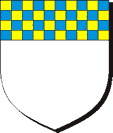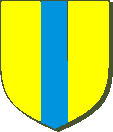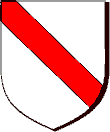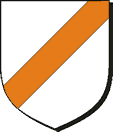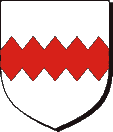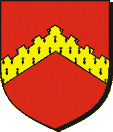Chief
The chief is a broad band across the top of the shield that stands for authority and domination of will. The chief has often been granted as a special reward for prudence and wisdom, as well as for successful command in war. The chief theoretically contains the upper 1/3 of the shield, although it rarely actually does. The chief is never surmounted by any other ordinary (a simple background symbol) except for in very exceptional cases. A chief is also never couped (cut off before reaching the edges of the shield) or cottised (surrounded closely by smaller bars), and it has no diminutive.
Pale
The pale is a vertical band down the shield denoting great defensive military strength. Protective railings were made of pales. It has often been bestowed on those who have defended cities, supported the government of their sovereign, or stood strong for their country under stress. The guidelines of heraldry instruct that the pale is to occupy one third of the width of the shield, though this is not always strictly followed. The pallet or palet is a diminutive of the pale. Numerous pallets are often found on a shield, and when the field is striped vertically it is said to be "paly."
Bend
The bend is a broad, diagonal band across the shield representing either a scarf worn like a sash, or the shield suspender of a knight or military commander. It has often been granted to those who have distinguished themselves as commodores. The bend signifies defense or protection, and is a bearing of high honor. Unless it is specified otherwise the bend is assumed to go from the upper right corner of a shield to the lower left. The bend sinister follows the opposite diagonal. According to old theorists the bend should occupy one third of the surface of a shield, though it is usually drawn slightly more narrowly than this. A charge half the width of a bend is termed a bendlet, and if six or eight of these pieces occurs on a shield it is termed "bendy," though the number must be specified.
Bend Sinister
The bend sinister has been used occasionally as a mark of illegitimacy though this is not commonly the case. More often a bendlet sinister is used, or a baton sinister, which is a bendlet that does not extend to the very edges of the shield.
Fess(e)
The fesse is a broad, horizontal band across the center of the shield that represents the military belt and girdle of honor of the ancients. It signifies that the bearer must always be in readiness to act for the well being of the people. It is supposed to occupy a full third of the height of the shield, though it is seldom drawn this way, and it is subject to the lines of partition. Its position is directly across the center of the shield unless the fesse is described as enhanced or abased. There can only be one fesse on a shield. If more than one is present then they are termed bars. The term "bar sinister" is quite simply an impossible term of heraldry - one must assume that the layman who quotes such a term means a bend sinister.
Cross
The cross is a common heraldic device that signifies the Christian faith of the bearer. It was a popular symbol during the crusades and it is said that during the first Crusades the principle nations of Christendom were distinguished by different colored crosses. A plain cross, one that divides the shield into roughly equal partitions, is also called a Greek cross to distinguish it from the Latin cross where the lower member is much longer than the other three, stemming from the time when the shields were much more elongated. The plain cross is often thought of as the cross Saint George, the patron saint of England. Though his emblem is properly a red cross on a white field, the shape of this cross is common in heraldry and is used often as either a charge or an ordinary, may be charged with other devices and is subject to the lines of partition. It may also be formed by bars or barrulets, parted and fretty, meaning that they are interlaced; it may be quarter-pierced or quarter-voided with the central piece where the two bars overlap removed, or voided, meaning that the center of the cross is the same color as the field, with only a narrow border left.
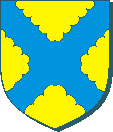
Saltire
The saltire is most often found in Scottish arms because it is the well-known cross of St. Andrew, the patron saint of Scotland. It is a cross running from corner to corner rather than vertically and horizontally like a crucifix. The saltire symbolizes suffering for faith and the endurance of hardships.
Chevron
The chevron occurs very frequently in British and French heraldry, and is comparatively rare in German heraldry. The chevron represents the roof of a house, derived from the French word "chevron" meaning rafter. It signifies protection. The chevron was granted to those who had participated in some notable enterprise, had built churches or fortresses, or had accomplished some work requiring faithful service. The chevron used to almost reach the very top of the shield and then more nearly attained the 1/3 of the surface of the shield that was allotted to it by the guidelines of heraldry. Now it is drawn lower and with a less acute inner angle to allow more devices to be represented more attractively, and an artist may draw the chevron at the height and angle that will best suit the accompanying charges. The chevronel, is the diminutive of the chevron and is much narrower. Chevronels may be stacked on top of each other or side-by-side at the same height, which is termed interlaced, or braced. A field composed entirely of an even number of chevrons is called "chevronny."
- ^ Swyrich, Archive materials
